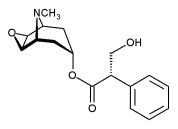Hyoscine
Scopolamine, also known as hyoscine, is a tropane alkaloid drug obtained from plants of the Solanaceae family (Nightshade), such as henbane or jimson weed (Datura stramonium). It is part of the secondary metabolites of plants. more...
It is structurally similar to the neurotransmitter acetylcholine and acts by blocking the muscarinic acetylcholine receptors; it is thus classified as an anticholinergic.
In medicine, it is usually used in the form scopolamine hydrobromide. It can be used as a depressant of the central nervous system, though it can cause delirium in the presence of pain, mydriasis (pupillary dilation), and cycloplegia (paralysis of the eye muscles). When combined with morphine, it produces a tranquilized state known as twilight sleep and amnesia. Although originally used in obstetrics it is now considered dangerous.
It is used in ophthalmology to deliberately cause cycloplegia and mydriasis so that certain diagnostic procedures may be performed. It is also used in the treatment of iridocyclitis.
In otolaryngology it has been used to ease the trauma of intubation.
It is also an antiemetic (prevents vomiting), antivertigo (prevents dizziness), and antispasmodic (reduces smooth muscle contractions; although a derivate called butylscopolamine, that does not cross the BBB, is used preferably). It can be used as a pre-anesthetic sedation, as an antiarrhythmic (preventing irregular heartbeat) during anesthesia, and for the prevention of motion sickness.
The drug is highly toxic and has to be used in minute doses. An overdose can cause delirium, delusions, paralysis, stupor and death.
The use of scopolamine as a truth drug was investigated by various intelligence agencies, including the CIA, during the 50s. see:Project MKULTRA. It was found that, due to the hallucinogenic side effects of the drug, the truth was prone to distortion, and the project was subsequently abandoned.
Scopolamine is used criminally as a date rape drug and as an aid to robbery, the most common act being the clandestine drugging of a victim's drink. It is preferred because it induces retrograde amnesia, or an inability to recall events prior to its administration. Victims of this crime are often admitted to a hospital in police custody, under the assumption that the patient is experiencing a psychotic episode. A telltale sign is a fever accompanied by a lack of sweat.
In Colombia a plant admixture containing scopolamine called Burundanga has been used shamanically for decades. In recent years its criminal use (as outlined above) has become an epidemic. Approximately fifty percent of emergency room admissions for poisoning in Bogotá have been attributed to scopolamine.
Due to its effectiveness against sea-sickness it has become commonly used by scuba divers. However, this has lead to the discovery of another side effect. In deep water, below 50-60 feet, some divers have reported pain in the eyes, but the pain subsides quickly if the diver ascends to a depth of 40 feet or less. No study has been reported regarding the drug's effect on intra-ocular pressure or its effect on the eye's ability to adjust to pressure, so the medication should be used with extra caution among divers who intend to go below 50 feet.
Read more at Wikipedia.org



